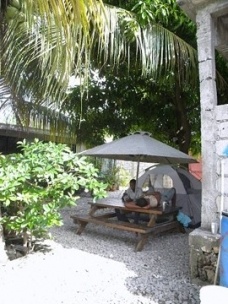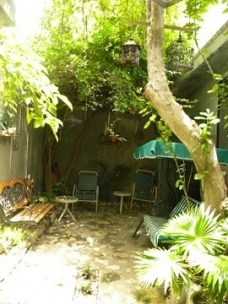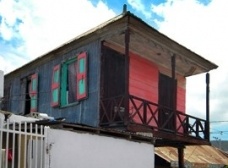
newspaper
competitions
Through this competition, we will be building five housing units in St. Marc, Haiti – a coastal town approximately 100 km north of the Haitian capital Port-au-Prince
Welcome to the home of Kay e Sante nan Ayiti – the ARCHIVE Institute’s Open Innovation Competition! The project's title is Creole for Housing and Health in Haiti - two issues about which ARCHIVE is passionate since we believe that intelligently designed housing can dramatically improve people’s health.
What makes our project truly unique is that throughout the entire process - from design, construction through to habitation - health is a key ingredient.
The design and construction of the housing units should make use of common sense principles which seek to minimize the transmission of Tuberculosis. ARCHIVE hopes that the competition will raise awareness of housing’s ability to change the way in which society deals with global health. We like to imagine that all those involved in the project will walk away with a newfound understanding of the interconnected relationship between housing and health.
The project will be led by you - the public! We feel that the Kay e Sante nan Ayiti project will only reach the best design solutions through the exciting and interdisciplinary collaboration of minds, skills, interests and people.
Individuals, students and professionals from across the globe can submit housing designs according to the brief and the top 5 winning designs will be built in 2011, with habitation commencing in July 2011. The community of St. Marc will also be active participants in the project, helping refine the final ideas to ensure the long term viability of the project. Two juries comprised of international experts and community members will be engaged along the way and ultimately be responsible for choosing the 5 winning entries and 2 honorable mentions. Yet our work does not end when the houses are built! To continue to raise global awareness about the health and housing link, ARCHIVE will be publishing compendiums featuring the competition’s strongest entries and best practice examples. Honorable mentions for projects strong in certain disciplines will also be noted. ARCHIVE will finally host a travelling project exhibition to showcase the work to various universities worldwide.
The project will adhere to the following timeline:
12 July 2010
Campaign launched
20 September
Design teams formed and registered on ARCHIVE website
12 November
Deadline for entry submission
1 December
1st round judging completed; 20 winners announced
7 December
Final 5 winners announced
12 January 2011 (1-year anniversary of earthquake
Launch of travel exhibit
1 March
Construction of pilot houses begins
31 May
Construction of selected units completed
July
Building occupancy of completed units
Jury
Juan Carlos Sanabria
Director of School of Architecture. Veritas University. San Jose, Costa Rica
Juan Carlos Sanabria is a practicing architect in Costa Rica, and is principal at Murillo + Sanabria Architecture. He is the co-founder of SAAi (Sustainable Architecture Advisors International), a firm working worldwide on consultancy related to energy, environment, and sustainable design. Juan Carlos has recently taken part in the London Festival of Architecture, curating an exhibition showcasing Costa Rica's architecture, its strategies and design in a tropical context. His firm offers consultancy in infrastructure, landscaping, architecture, and sustainable design, always ensuring work is fitted to its context. As director of the School of Architecture he lectures extensively.
Tiziana Rossetto
Director of MSc in Earthquake Engineering with Disaster Management. Department of Civil, Environmental and Geomatic Engineering, University College London. London, UK
Tiziana Rossetto has lectured at UCL since 2004, and specializes in earthquake engineering. Prior to lecturing, she worked at civil engineering consultancy High-Point Rendel and was a researcher under the Seismic Assessment for Earthquake Risk Reduction at Imperial College. Since starting at UCL, Tiziana founded the EPSRC funded Earthquake and People Interaction Centre (EPICENTRE) which works to further knowledge on building vulnerability to earthquakes, tsunami and human-structure interaction. The Centre is a multi-disciplinary research group that embraces a holistic approach to earthquake engineering, addressing both engineering, social and cultural issues. Tiziana has published widely, and is a recognised scholar in earthquake engineering. She has undertaken a number of field missions to assess the damage to buildings and infrastructure in earthquake zones, and is interested in the psychological drivers behind people's behaviour in earthquakes and how this impacts their vulnerability within the urban environment.
Rodney Harber
Professor of Architecture, and Principal Architect/Urban Planner at Harber & Associates. Harber & Associates. South Africa
Professor Rodney Harber has worked as an architect and urban planner for forty years in South Africa, focusing on the areas of sustainable development, alternative technologies, conservation, and housing development. He has consistently had an interest in the problems faced by development in remote rural locations. And much of his work has focused on the particular challenges faced in these places, including the impact of HIV/AIDS, sustainability, nutrition, and training. He is an advocate for the built environment, in particular for Africa, and represents Africa on the UNESCO Council and UIA (International Union of Architects). He was a founder member of the Built Environment Support Group U.N. (1985) and is currently a director. His work has been the recipient of many awards and he lectures extensively on the subject of architecture and development. His expertise has led to him being a juror for Architecture for Humanity, a Special Advisor to U.N. Habitat, and a member of Global Studio.
Fabrizio Gallanti and Francisca Insulza
Urban Designers. Veritas University. San Jose, Costa Rica
FABRIZIO GALLANTI and FRANCISCA INSULZA are both practising architects currently based in Milan. They spent several years in Santiago, Chile, where they taught architectural design, architectural theory and advanced urbanism at Universidad Catolica and were visiting professors at Universidad Diego Portales. Together they won the first prize of the Europan 8 competition in Kristiansand, Norway. Fabrizio was a founding member of gruppo A12, a collective of architects dedicated to architectural design and art. In 1997 he won the Akademie Schloss Solitude Fellowship, Stuttgart (Germany) of which he was nominated Jury Chairman in 2001. He worked as a curator at the Milan Triennale (Italy) and in 2001 won the Canon Foundation Research Fellowship, Tokyo (Japan). He is a frequent collaborator with magazines such as Domus, Abitareand 32. Presently he collaborates with Interaction Design Lab, a multidisciplinary company based in Milan and Turin. Francisca Insulza has done considerable research into territorial transformations and the representation of urban dynamics. She was a founding member of the group multiplicity, and has been published in Hunch Architektur Aktuell and Domus.
Marco Poletto and Claudia Pasquero
Founders of EcoLogicStudio. EcoLogicStudio. London, UK
Claudia Pasquero and Marco Poletto co-founded EcoLogicStudio in 2004, an innovative design practice which focuses on digital computational design and its application to design methods. The practice's work has been exhibited at the London, Venice and Seville biennales in 2006 and 2008. They have run the Masters unit at the Architectural Association, 'Interhttp://www.vitruvius.es/mediate Unit 10' since 2007. It is an experimental unit focusing on urban laboratories, and encourages people to explore architecture as a means of managing materials in a creative way. Their experimental attitude to work has led them to lecture and work internationally, collaborating within a multidisciplinary network of partners. Marco and Claudia directed the AA Visiting Workshops in Turin and Istanbul, and curated the AA Architectural Machines Symposium.
Hector Altamirano
Researcher at the 'Healthy Infrastructure Research Centre. Department of Civil, Environmental and Geomatic Engineering, UCL. London, UK
Hector Altamarino holds a B-Arch from the Universidad Central de Chile and an MA in energy, environment and sustainable design from the Architectural Association School of Architecture. He has worked as an architect on social housing for the Chilean government and private organizations. His interest lies in the health impact of buildings, including mold growth, indoor and outdoor air quality. He has lectured on these subjects at Universidad Central de Chile and University College London. Currently he is working on the control of indoor mold in UK dwellings and on the understanding of outdoor pathogens and buildings.
Peter Guthrie OBE
RedR Founder. Cambridge, England
Peter Guthrie is Professor of Engineering for Sustainable Development at the University of Cambridge. With a background in civil engineering practice, Peter has been involved in several major schemes such as the Channel Tunnel Rail Link, the West Coast Mainline, the Eden Project, and currently the Olympic Games in London in 2012. He is a member of the Scientific Advisory Council of DEFRA.
Peter has lived in Nigeria and Lesotho working on civil engineering projects. He has undertaken several specialist appraisal and evaluation missions to Sudan, Botswana, Ethiopia, Russia, Mauritius, South Africa and the Philippines. Peter is a Fellow of the Royal Academy of Engineering and a Vice-President of RedR, of which he was a founder.
Paul Pholeros
Adjunct Associate Professor, Director, Healthabitat. University of Sydney. Sydney, Australia
Paul Pholeros trained as an architect at the University of Sydney, and has run a private architectural practice working on urban, rural and remote are projects throughout Australia since 1984. He is also a partner of Healthabitat, (with a medical doctor and an anthropologist/public health officer). For over 12 years Healthabitat has worked to improve the health of Aboriginal people, particularly children, by making healthier living environments in many remote, and more recently rural and suburban, areas of Australia. One of the projects involving the work was decided in the book 'Housing for Health' which subsequently received the Royal Australian Institute of Architects President's Award in 1994.
Jo da Silva
Director of International Development. ARUP Group. London, UK
Jo da Silva joined ARUP after studying engineering at Cambridge University. She has considerable experience utilising her engineering skills and knowledge in international development and humanitarian relief. She has been a member of RedR (Engineers for Disaster Relief) since 1991, and has provided her expertise in post-disaster situations, risk reduction, urban regeneration, liason with government and funding bodies and project management. Her experience includes work in the Rwandan Genocide (1994) and as a Senior Shelter Co-ordinator for UNHCR in Sri Lanka post-tsunami (2005). For the project she was program manager for the delivery of 60,000 transitional shelters, combining engineering and humanitarian expertise to deliver all the units in 6 months. Da Silva's work led to her being awarded British Expertise Individual of the Year (2006). She is a Senior Visiting Fellow at the Department of Engineering, Cambridge University, as well as a Fellow of the Royal Academy of Engineering.
Graham Saunders
Head of Shelter. International Federation of Red Cross and Red Crescent Societies. Geneva, Switzerland
Graham Saunders trained as an architect and has experience in project design and management. His interests lie in shelter programming, disaster trends, shelter solutions, and partnerships on innovation. Graham Saunders has considerable experience in shelter programming in Africa, South & South East Asia, Eastern Europe, the Middle East, Latin America and the Caribbean, and has since been appointed Head of Shelter in the newly established department within the Secretariat in Geneva. He works to assist emergency shelter coordination in natural disasters, identifying good practice, and raising awareness. Following the Haitian earthquake Graham was instrumental in the coordination of humanitarian shelter agencies from across the United Nations, IFRC, other NGOs, and the Haitian government.
Edward Nardell
Associate Professor. Harvard Medical School, Harvard School of Public Health, Partners in Health. Boston, MA
Edward Nardell is associate professor of medicine at Harvard Medical School, with parallel appointments in the Department of Global Health and Social Medicine, and the Harvard School of Public Health. His expertise lies in TB infection control and in 2002 he joined Partners in Health as Director of TB research. He has also been positioned as a full-time researcher in the Division of Global Health Equity, Brigham & Women's Hospital. He has conducted research into the control of multidrug resistant tuberculosis, airborne transmission of TB, and has since organized and co-chaired the first post graduate course to build control airborne infections in high-burden countries. He has experience working in pulmonary medicine, and was director of TB control for the city of Cambridge for 24 years. He is currently conducting research in South Africa into the effectiveness of various control interventions to the infectiousness of TB.
Leopold Blanc
Coordinator, Stop TB. World Heath Organization. Geneva, Switzerland
Léopold Blanc presently coordinates WHO's work on policies, norms and new approaches for the implementation of the Stop TB strategy which includes the increase in case detection, control of MDR-TB and TB/HIV. In 2000, he headed the Global DOTS expansion plan which included the development of cost estimates and the strategy for collaboration with partners engaged in TB control. He now coordinates its implementation through WHO's network in the regions and countries, in collaboration with partner organizations. In 1993, he joined the WHO Western Pacific Regional Office as Regional Adviser for TB and Leprosy, during which time the elimination of leprosy as a public health problem was achieved and the foundations for TB control in the region were laid. Earlier in his career, as head of the Department of Epidemiology and Training in the Institut Marchoux (Mali), and as a field worker in Niger, he led, or participated in, various clinical trials, clinical research and operational research in dermatological diseases and leprosy. As a General Practitioner he specialized in Tropical Medicine and Parasitology in Lille (France), and graduated in Epidemiology and Public Health from Nancy (France) and Johns Hopkins School of Public Health (USA).
Esther Boucicault
Founder of FEBS. FEBS (Foundation Esther Boucicault-Stanislas), Haitian AIDS Organization. St. Marc, Haiti
Esther Boucicault Stanislas, founder of FEBS and CAPEBS, has forged the way for PLWHA in a country where stigmatization made being open about HIV/AIDS a difficult path. In 1995, when Esther aired on Haitian radio and television programs announcing her own HIV+ status, she became known as the first person to speak publicly about the epidemic and has since given a voice to those living with HIV/AIDS in her home country. Her courageousness has allowed for free health care and nutritional support now available to PLWHA through her organization.
She has two daughters, Michele, 28, and Stephanie, 14. Her entire family has been incredibly supportive and she feels she would not have been able to endure the persecution without their help. Her motto is that there is positivity in seropositivity and that HIV is not the end of life, but rather the beginning of a new way of living.
Rod Escombe
Honorary Research Fellow. Division of Investigative Science, Imperial College. London, UK
Dr Rod Escombe is a leading researcher in the field of TB and its transmission. He has studied how the TB epidemic is heightened by people living with HIV, particularly in poor environments and developing countries. He has published studies on how to reduce TB transmission and its relation to airborne movement. Much of this research can be applied to building principles, and he has written extensively on how simple techniques such as opening windows have a big impact on reduction of TB transmission. This research has been put into practice in selected prisons and hospitals in Peru, which through implementing natural ventilation techniques into the building design have increased air ventilation, more so than with mechanical ventilation. He has presented his work to 'The International Union Against TB and Lung Disease' at their world conference in 2007 and 2008.
Zaha Hadid Architects
Founding Director. Zaha Hadid Architects. London, UK
The firm of Zaha Hadid Architects was founded and is chaired by Zaha Hadid, the original and creative architect who was named by Forbes as 69th most powerful woman in the world, and in 2004 won the Pritzker Architecture Prize. The firm itself is based in London and has more than 350 staff. The firm is known internationally for its built work, as well as its theoretical designs. All designs are trademarked by their innovation, and often revolutionary approach to space, place and material. Stylistically and conceptually, the firm is interested in the interface between architecture, landscape and geology. Staff are currently working on the aquatics centre for the London Olympics, High Speed Train Stations in Naples and Durango, and masterplans for Beijing, Bilbao, Istanbul, Singapore and the Middle East. The firm is known for its bold vision and radical designs, ensuring that all work the firm produces is innovative and gives unexpected results.
Kenneth Yeang
Chairman. Llewelyn Davis Yeang. London, UK
Dr. Ken Yeang is the chairman of a leading architecture and planning firm, Llewelyn Davies Yeang. He was recently named by the Guardian as one of 50 individuals who could save the planet. And he was named as the leading architect in ecological design by CNN. Yeang uses vegetation to create habitats in his buildings as total living systems, renewable energies such as photovoltaics, scallop-shaped sunshades for rainwater harvesting, advanced ventilation and light-pipe systems to make buildings perform as complete ecosystems. He balances between engineering infrastructure and designing to mimic nature. He has developed over 30 years of research, delivered over 200 built projects and authored over 5 books on ecological design. His designs are always grounded in environmental principles and are the inspiration for innovative green tall building. The ‘bioclimatic skyscraper’, one of his masterpieces, champions vertical urban design.





